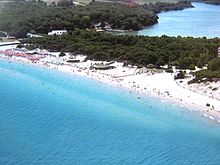
Back Kus Afrikaans Costa AN ساحل Arabic لاكوط ARY Costa AST Lamara junt'u tuqi suyu Aymara Gstod BAR Узбярэжжа Byelorussian Узьбярэжжа BE-X-OLD Pesisir BEW





A coast – also called the coastline, shoreline, or seashore – is the land next to the sea or the line that forms the boundary between the land and the ocean or a lake.[1][2] Coasts are influenced by the topography of the surrounding landscape, as well as by water induced erosion, such as waves. The geological composition of rock and soil dictates the type of shore that is created. Earth contains roughly 620,000 km (390,000 mi) of coastline.
Coasts are important zones in natural ecosystems, often home to a wide range of biodiversity. On land, they harbor important ecosystems such as freshwater or estuarine wetlands, which are important for bird populations and other terrestrial animals. In wave-protected areas, they harbor salt marshes, mangroves or seagrasses, all of which can provide nursery habitat for finfish, shellfish, and other aquatic animals.[3][4] Rocky shores are usually found along exposed coasts and provide habitat for a wide range of sessile animals (e.g. mussels, starfish, barnacles) and various kinds of seaweeds.
In physical oceanography, a shore is the wider fringe that is geologically modified by the action of the body of water past and present, while the beach is at the edge of the shore, representing the intertidal zone where there is one.[5] Along tropical coasts with clear, nutrient-poor water, coral reefs can often be found between depths of 1–50 m (3.3–164.0 ft).
According to an atlas prepared by the United Nations, about 44% of the human population lives within 150 km (93 mi) of the sea as of 2013[update].[6] Due to its importance in society and its high population concentrations, the coast is important for major parts of the global food and economic system, and they provide many ecosystem services to humankind. For example, important human activities happen in port cities. Coastal fisheries (commercial, recreational, and subsistence) and aquaculture are major economic activities and create jobs, livelihoods, and protein for the majority of coastal human populations. Other coastal spaces like beaches and seaside resorts generate large revenues through tourism.
Marine coastal ecosystems can also provide protection against sea level rise and tsunamis. In many countries, mangroves are the primary source of wood for fuel (e.g. charcoal) and building material. Coastal ecosystems like mangroves and seagrasses have a much higher capacity for carbon sequestration than many terrestrial ecosystems, and as such can play a critical role in the near-future to help mitigate climate change effects by uptake of atmospheric anthropogenic carbon dioxide.
However, the economic importance of coasts makes many of these communities vulnerable to climate change, which causes increases in extreme weather and sea level rise, as well as related issues like coastal erosion, saltwater intrusion, and coastal flooding.[7] Other coastal issues, such as marine pollution, marine debris, coastal development, and marine ecosystem destruction, further complicate the human uses of the coast and threaten coastal ecosystems.[7]
The interactive effects of climate change, habitat destruction, overfishing, and water pollution (especially eutrophication) have led to the demise of coastal ecosystem around the globe. This has resulted in population collapse of fisheries stocks, loss of biodiversity, increased invasion of alien species, and loss of healthy habitats. International attention to these issues has been captured in Sustainable Development Goal 14 "Life Below Water", which sets goals for international policy focused on preserving marine coastal ecosystems and supporting more sustainable economic practices for coastal communities.[8] Likewise, the United Nations has declared 2021–2030 the UN Decade on Ecosystem Restoration, but restoration of coastal ecosystems has received insufficient attention.[9]
Since coasts are constantly changing, a coastline's exact perimeter cannot be determined; this measurement challenge is called the coastline paradox. The term coastal zone is used to refer to a region where interactions of sea and land processes occur.[10] Both the terms coast and coastal are often used to describe a geographic location or region located on a coastline (e.g., New Zealand's West Coast, or the East, West, and Gulf Coast of the United States.) Coasts with a narrow continental shelf that are close to the open ocean are called pelagic coast, while other coasts are more sheltered coast in a gulf or bay. A shore, on the other hand, may refer to parts of land adjoining any large body of water, including oceans (sea shore) and lakes (lake shore).
- ^ "coast". The American Heritage Dictionary of the English Language (5th ed.). HarperCollins. Retrieved 2024-07-19.
- ^ "coastline". Merriam-Webster.com Dictionary. Merriam-Webster. Retrieved 2024-07-19.
- ^ Nagelkerken, Ivan, ed. (2009). Ecological Connectivity Among Tropical Coastal Ecosystems. Dordrecht: Springer Netherlands. doi:10.1007/978-90-481-2406-0. ISBN 978-90-481-2405-3.
- ^ Nagelkerken, I.; Blaber, S.J.M.; Bouillon, S.; Green, P.; Haywood, M.; Kirton, L.G.; Meynecke, J.-O.; Pawlik, J.; Penrose, H.M.; Sasekumar, A.; Somerfield, P.J. (2008). "The habitat function of mangroves for terrestrial and marine fauna: A review". Aquatic Botany. 89 (2): 155–185. Bibcode:2008AqBot..89..155N. doi:10.1016/j.aquabot.2007.12.007.
- ^ Pickard, George L.; Emery, William J. (1990). Descriptive Physical Oceanography (5th (illustrated) ed.). Elsevier. pp. 7–8. ISBN 0-7506-2759-X.
- ^ "UN Atlas of the Oceans". CoastalChallenges.com. Archived from the original on 2 November 2013. Retrieved 2013-10-31.
- ^ a b "Climate change and the coasts". World Ocean Review. Retrieved 2020-12-19.
- ^ United Nations (2017) Resolution adopted by the General Assembly on 6 July 2017, Work of the Statistical Commission pertaining to the 2030 Agenda for Sustainable Development (A/RES/71/313)
- ^ Waltham, Nathan J.; Elliott, Michael; Lee, Shing Yip; Lovelock, Catherine; Duarte, Carlos M.; Buelow, Christina; Simenstad, Charles; Nagelkerken, Ivan; Claassens, Louw; Wen, Colin K-C; Barletta, Mario (2020). "UN Decade on Ecosystem Restoration 2021–2030—What Chance for Success in Restoring Coastal Ecosystems?". Frontiers in Marine Science. 7: 71. doi:10.3389/fmars.2020.00071. hdl:2440/123896. ISSN 2296-7745.
- ^ Nelson, Stephen A. (2007). "Coastal Zones". Archived from the original on 2013-03-16. Retrieved 2008-12-11.